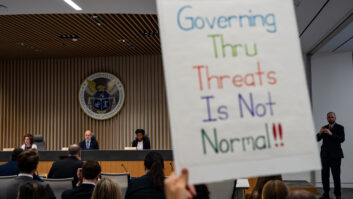The FCC at its open meeting later this month will vote on new rules to allow low-power FM stations in the United States the use of directional antennas and FM booster stations.
The FCC’s Report and Order will update the technical rules for low-power FM (LPFM) stations and allow them to take advantage of additional engineering options to improve reception, according to the FCC. The LPFM service is two decades old and has grown to over 2,100 stations.
The commission’s vote on the reforms this month would “increase flexibility while maintaining interference protection and the core LPFM goals of diversity and localism,” according to the FCC.
[Read: COVID-19 Updates: Next FCC Meeting Is Online Only, Format Adaptations & More]
LPFM advocates have been pushing the FCC for technical upgrades to improve reception. The approximate service range of a 100 watt LPFM station is about 3.5 miles, according to the FCC.
The new LPFM rules on directional antenna changes, which are based on a petition from REC Networks, would permit the use of custom directional antennas, as opposed to off the shelf, in certain cases.
Michi Bradley, founder of REC Networks and an LPFM advocate, previously told Radio World the newly proposed rules are “not a carte blanche for all LPFMs” to use directional antennas.
The FCC in its Notice of Proposed Rulemaking last year said it didn’t think the use of DAs will be widespread: “We believe that directional antennas, whether off-the-shelf or custom models, will not be used widely in the LPFM service due to their higher cost and limited necessity. Nevertheless, the use of such antennas could, if properly engineered, provide significant flexibility to LPFM licensees subject to international agreements and to those that must relocate in areas with few available transmitter sites,” according to the FCC.
FCC Chairman Ajit Pai in a blog post this week pointed out several LPFM radio stations that are providing their communities with up-to-date information during the coronavirus pandemic in this country; specifically mentioning WNQZ(LP) in New Orleans, which has been carrying locally produced public service announcements.
In addition, he wrote: “WOMP(LP) in Cambridge, Ohio, which has been carrying local church services, serving the elderly and low-income Americans who are particularly isolated and lack access to streaming services. And KDRT(LP) in Davis, Calif., which stepped up to serve its community after the local college radio station was forced off the air by the pandemic.”
The FCC’s rulemaking process did draw comments from some observers worried the reforms could bring increased congestion to the FM band. For example, Entercom Communications, in a Notice of Ex Parte Communication, noted during a meeting with FCC Chairman Pai last fall the broadcaster expressed concern that certain modifications to the LPFM technical rules proposed “could bring increased congestion to the FM dial leading to interference to full-power stations.”
The National Association of Broadcasters also wrote about concerns they had with several aspects of the proposed rule changes.
“NAB is concerned that the proposal to allow LPFM licensees expanded use of directional antennas could cause interference to full-service FM stations. We further object to the commission’s proposal to grant a blanket authorization to LPFM operators to use boosters,” NAB wrote in its comments.
The FCC has previously rejected proposals to allow LPFM stations to increase power greater than 100 watts. LPFM advocates, including REC Networks, have previously asked for a 250 watt service (LP250).
The FCC’s April Open Meeting is scheduled for April 23 in Washington.




